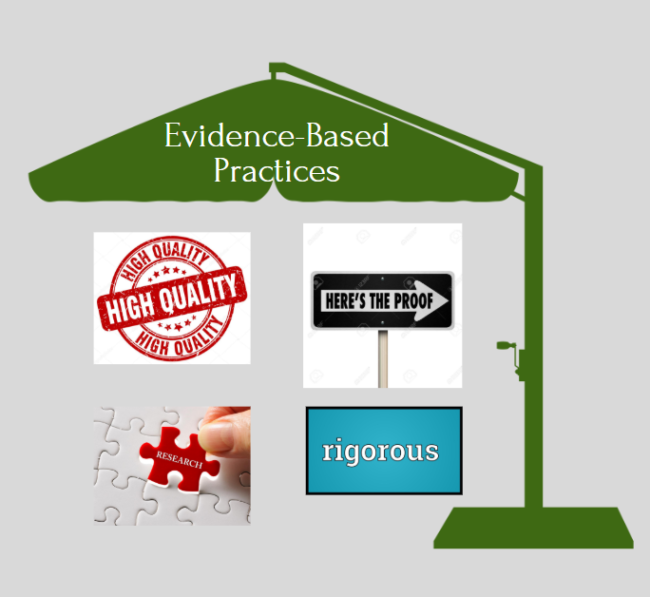What Are Evidence-Based Practices?

Cook, Smith, and Tankersley (2012) define evidence-based practices (EBP) as practices that are shown to be effective through the high-quality researcher to meaningfully improve student outcomes. Simply put, EBPs are practices that are supported by a strong high-quality evidence base that have seen effects that positively impact students.

Think about EBPs like this…you go and visit your doctor and talk to them about your high blood pressure. In going to the doctor, the doctor prescribes you medication to treat your high blood pressure. The medication the doctor has given you has been through rigorous research, clinical trials and approval from the FDA. The blood pressure medication is more than likely to have a positive impact on lowering your blood pressure to a healthy level. The doctor prescribing the medication to you is aware of this research and uses his knowledge to prescribe the medication that will best fit your needs. The doctor knowing the research and the effects of the medication on your blood pressure takes the guess work out of finding a treatment that will lower your blood pressure.

Evidence-based practices in education are the same. They are backed by rigorous, high-standard research, replicated with positive outcomes and backed by their effects of student outcomes. EBPs take the guess work out of teaching by providing specific approaches and programs that improve student performance. There is frustration in teaching when you cannot find a way to help your student learn. You try one thing and then another and another and they are not having positive outcomes for your student. EBPs have proven outcomes on students’ performance and can make finding and implementing an effective practice less frustrating.

The term that is most thrown around in the education circle is the phrase “best practice.” Best practice is a vague term that could include anything from something you saw in an add to a practice that is actually ineffective but someone loves it and so it becomes a “best practice.” Best practices are inherently biased because of personal experiences, opinion or the claim that they are backed by science. Think about all the stuff that you see on a teachers personal blog, Teachers Pay Teachers or Pinterest. While they look cute and they seem like they would work in your classroom, none of those practices or materials are backed by scientific research. Think about how many curriculum programs, supplemental materials, or “best practice” that you have been through in your career. You use a reading series for 2 years, it’s not helping kids read and your on to the next “best thing.” Hype surrounding programs and approaches in education are often times backed by popularity and non by science. Big names in education come out with a new approach to reading and claim it’s the way to teach kids to read. However, the claim they are making is not backed by research. Their claims are backed by their standing as “one of the big ones,” one of the companies you can trust.

There is another term floating around in the education world and that is “effective practice.” Just as best practice insinuates, effective practices may be back by research but that research may not be high quality. There could be false positives, limited studies or small or negative effect sizes that impact these practices being named evidence-based. Think about effective practices like this…you have a headache and you want to treat it. You’ve heard through the grapevine that peppermint oil can help to get rid of a headache. You try the peppermint oil and its lessens your headache but the next three times you use it, it does nothing. You treat your next headache with some pain reliving medication and this does the trick. Peppermint oil can be an effective treatment for getting rid of a headache, but it is not evidence-based. There is no high-quality research to back up peppermint oil, no clinical trials and no randomized control trials to prove it’s effectiveness. It’s effectiveness is validated through companies that sell it, social media, holistic medicine and people you know.

Using evidence-based practices (EBPs), with special education students especially, is a critical feature of improving their learning outcomes. When teachers combine their expertise as content knowledge experts with explicit instruction and practices and programs backed by research, the likelihood that a child will grow academically is increased tenfold.

We will further explore what a high-quality research study looks like, what research design, magnitude and effect sizes have to do with evidence-based practices and provide resources and information for selecting and implementing an evidence-based practice in the classroom.
References:
Cook, B. G., & Cook, S. C. (2011). Unraveling evidence-based practices in special education. Journal of Special Education, 47, 71–82.
Cook, B. G., Smith, G. J., & Tankersley, M. (2011). Evidence-based practices in education. In K. R. Harris, S. Graham, & T. Urdan (Eds.), APA educational psychology handbook (Volume 1) (pp. 495–528). Washington, DC: American Psychological Association.
Cook, B. G., Tankersley, M., Cook, L., & Landrum, T. J. (2008). Evidence-based practices in special education: Some practical considerations. Intervention in School & Clinic, 44, 69–75.\
Cook, B. G., Tankersley, M., & Landrum, T. J. (Eds.). (2009). Evidence-based practices for reading, math, writing, and behavior [Special issue]. Exceptional Children, 75.
Kretlow, A. G., & Blatz, S. L. (2011). The ABCs of evidence-based practice for teachers. TEACHING Exceptional Children, 43(5), 8–19.
Torres, C., Farley, C., & Cook, B. G. (In press). A special educator’s guide to successfully implementing evidence-based practices. TEACHING Exceptional Children, 45, 64-73.
